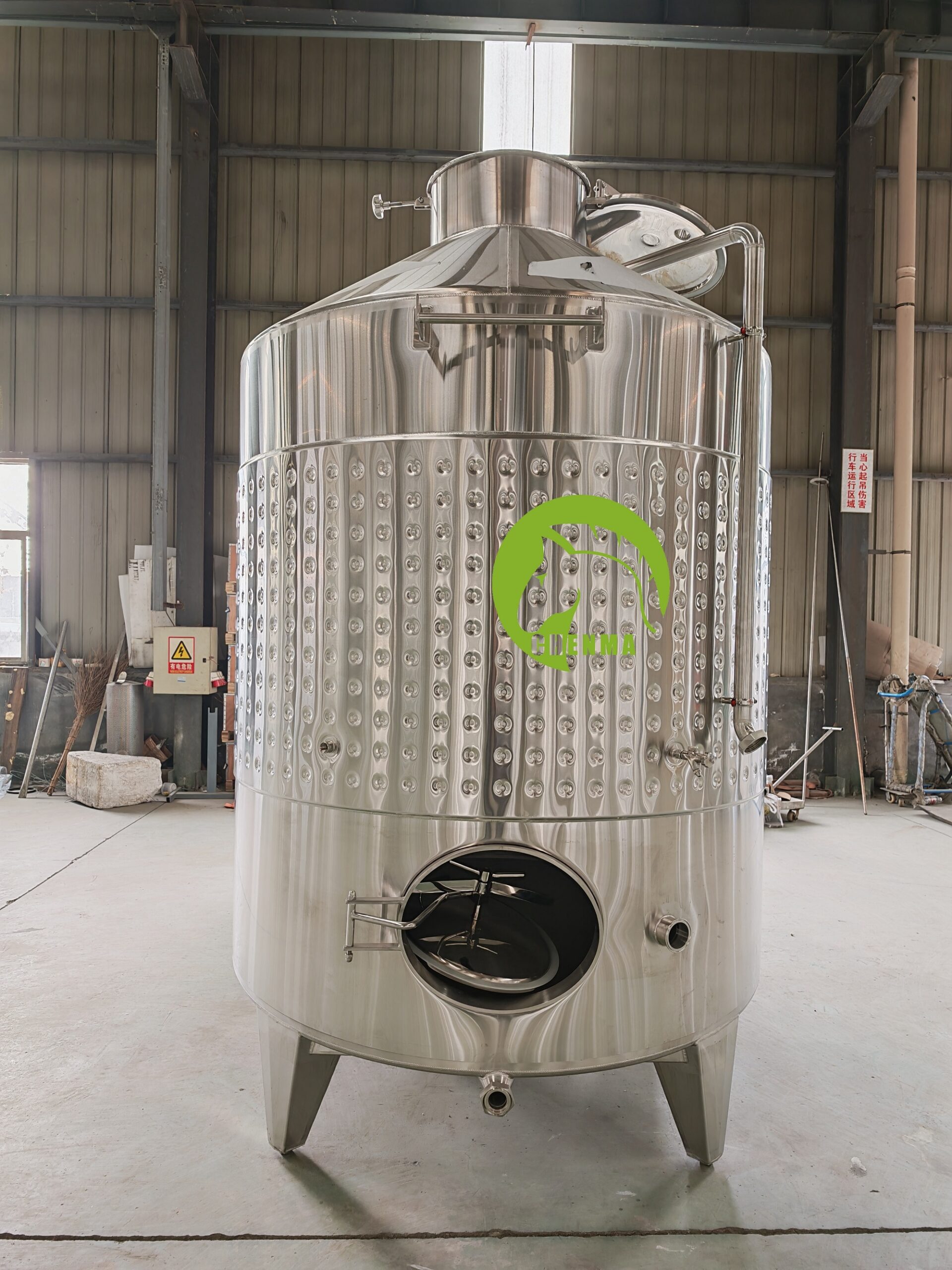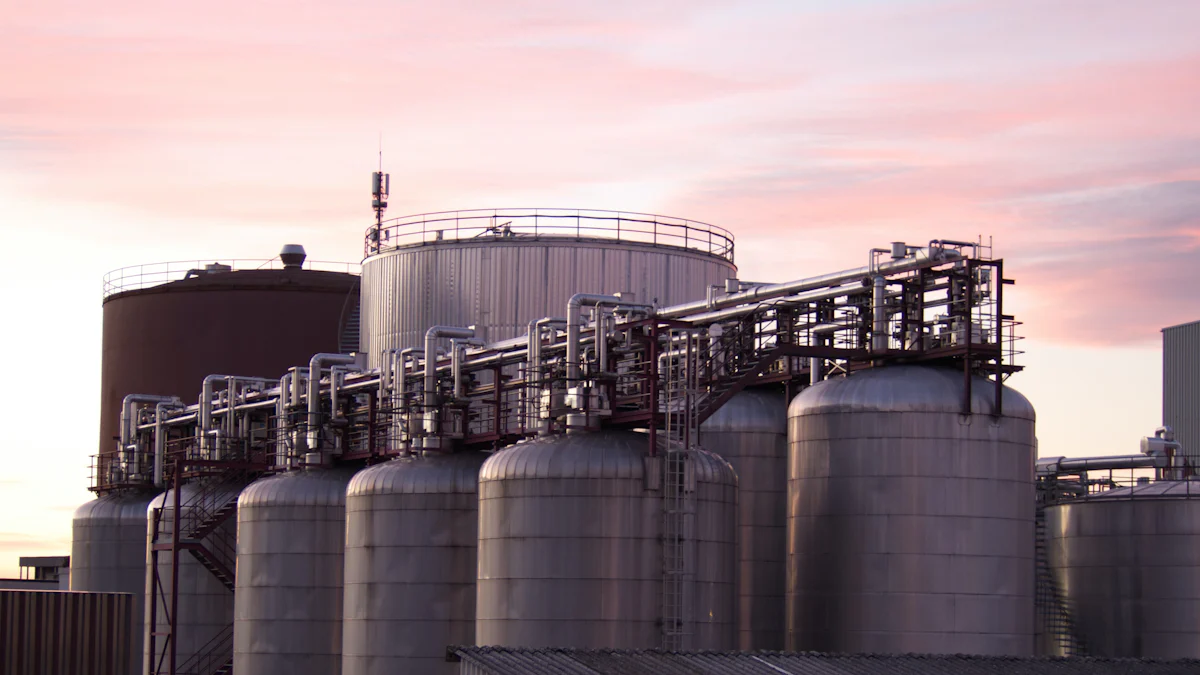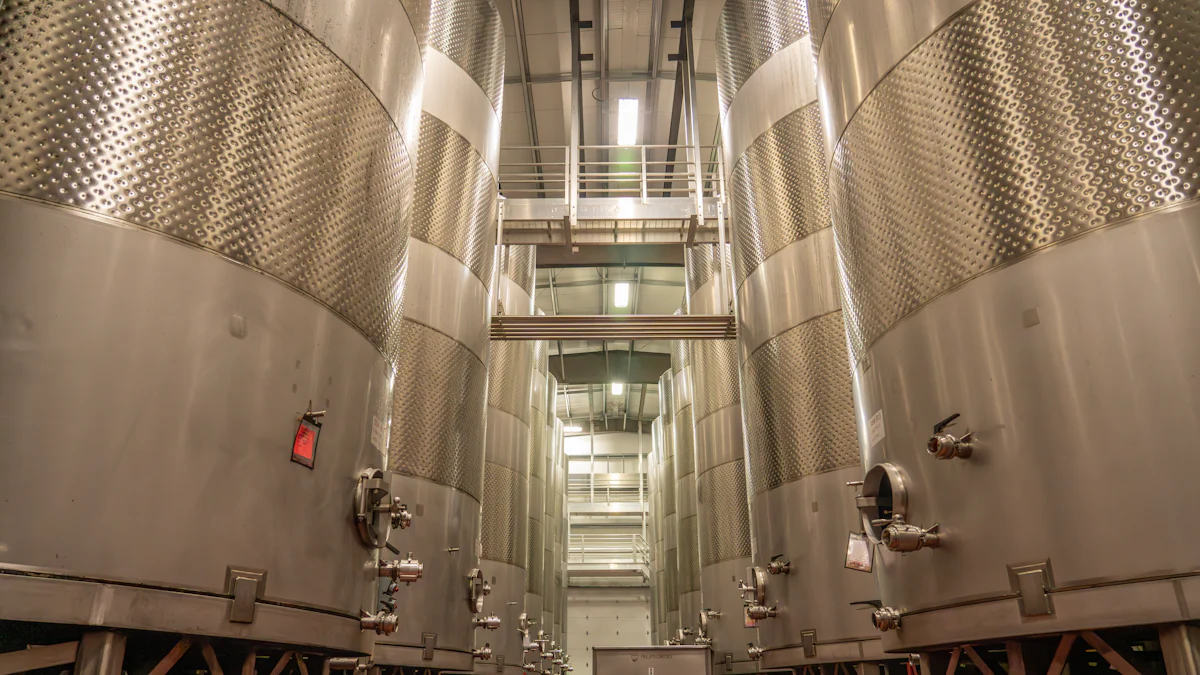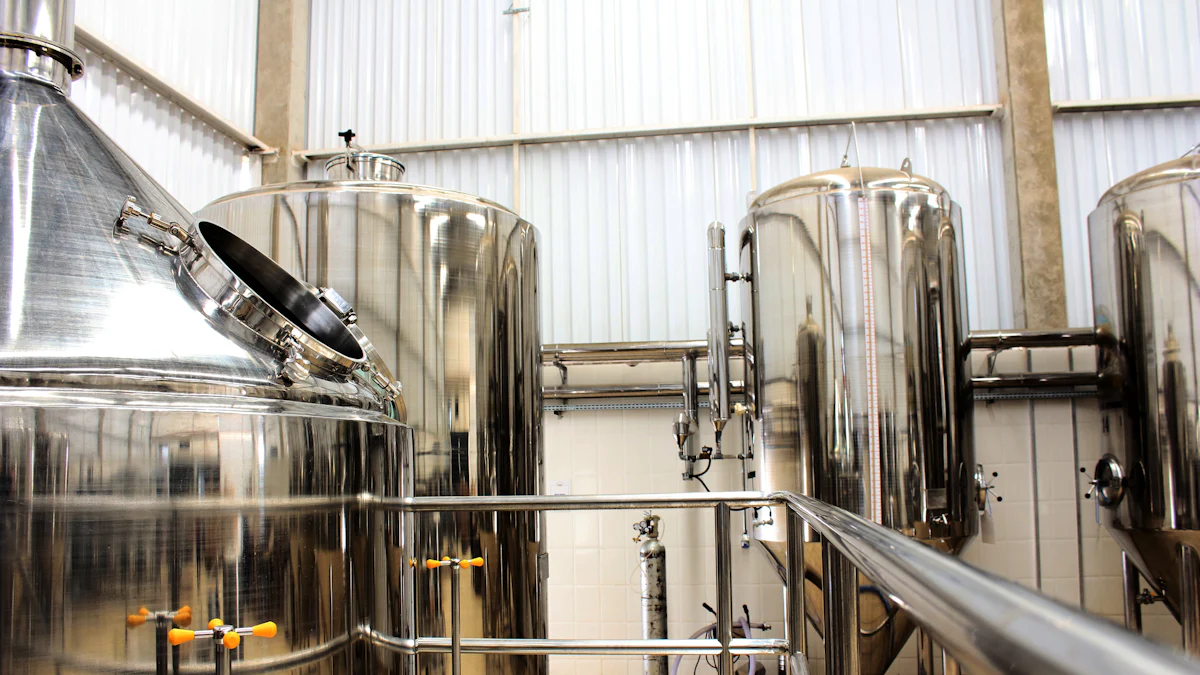
Stainless steel fermentation tanks wine have revolutionized the art of winemaking. These tanks offer unmatched durability and precision, making them a preferred choice for wine aging. Their non-porous surface prevents unwanted interactions with the wine, preserving the natural flavors of the grapes. You can rely on their smooth, corrosion-resistant design to simplify cleaning and maintain proper hygiene, which is critical for avoiding contamination. Additionally, their ability to regulate temperature ensures optimal conditions for fermentation and aging. While the initial investment may seem high, their long lifespan and minimal maintenance costs make them a cost-effective solution for winemakers like you.
Practical Advantages of Stainless Steel Tanks in Wine Aging
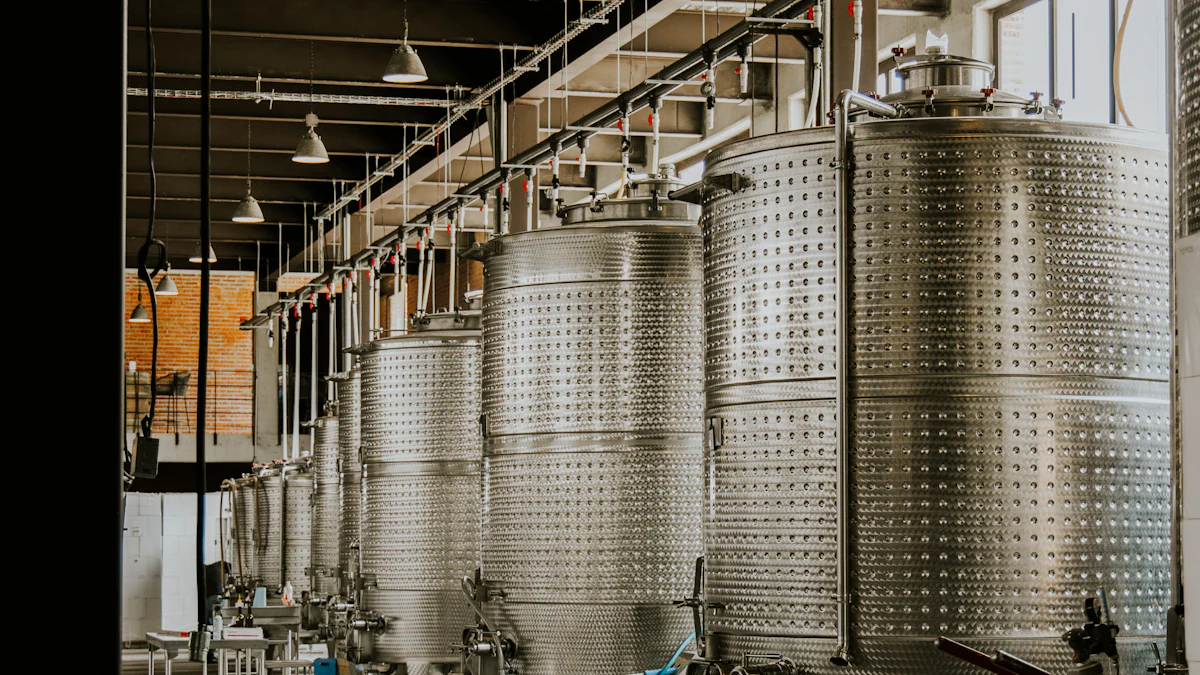
Easy Maintenance and Cleaning
Maintaining stainless steel fermentation tanks wine is straightforward, ensuring your winemaking process remains hygienic and efficient. These tanks feature a smooth, non-porous surface that resists bacterial growth and contamination. Cleaning them is a simple process that preserves wine quality and safety. You can follow these steps for effective cleaning:
- Start with a high-pressure rinse to remove debris.
- Use an alkaline cleaner to dissolve residues.
- Sanitize using hot water or approved chemicals.
- Rinse thoroughly to eliminate any remaining residue.
- Regular cleaning ensures hygiene and maintains the wine’s natural flavors.
This ease of maintenance not only saves you time but also ensures consistent results across batches. Unlike oak barrels or concrete tanks, stainless steel requires minimal effort to keep in pristine condition, making it an ideal choice for winemakers like you.
Long-Term Durability
Stainless steel tanks are built to last, offering unmatched durability in winemaking environments. With proper care, these tanks can serve you for decades, far outlasting oak barrels, which typically last only three to five years. Their corrosion-resistant properties ensure they remain functional even in demanding conditions.
| Advantage | Description |
|---|---|
| Long Service Life | Stainless steel tanks last decades, unlike oak barrels, which last 3-5 years. |
| Corrosion Resistance | Stainless steel resists corrosion, ensuring long-term durability. |
| Lower Maintenance Costs | Minimal upkeep reduces long-term expenses. |
The non-porous nature of stainless steel prevents bacterial growth, further enhancing its longevity. This durability makes stainless steel tanks a sustainable and reliable investment for your winery.
Cost-Effectiveness for Winemakers
While stainless steel tanks may have a higher upfront cost, they prove to be cost-effective over time. Their long lifespan means you won’t need frequent replacements, unlike oak barrels or plastic containers. Maintenance costs are also minimal due to their corrosion-resistant surface, which requires less upkeep.
Investing in stainless steel tanks ensures significant savings in the long run. Their durability and low maintenance needs offset the initial expense, making them a practical choice for winemakers. By choosing stainless steel, you gain a reliable solution that supports both your budget and your winemaking goals.
Precision and Control with Stainless Steel Fermentation Tanks
Temperature Regulation for Optimal Wine Aging
Stainless steel fermentation tanks wine provide precise temperature control, which is essential for producing high-quality wine. Maintaining the right temperature during fermentation and aging prevents undesirable chemical reactions that could alter the wine’s taste. You can adjust the temperature to enhance yeast activity, ensuring the wine develops its intended flavor profile.
Several technologies help regulate temperature effectively:
- Ice Bath: Immersing the tank in ice water to lower the temperature.
- Brew Belt: Wrapping an electric brew belt around the tank to gently raise the temperature.
- Room Heater: Heating the room where the tank is located to gradually increase the temperature.
- Evaporation: Covering the tank with a wet cloth to cool it through evaporation.
These methods allow you to create the ideal conditions for fermentation and aging. Stainless steel tanks also preserve the wine’s freshness by preventing oxidation, ensuring the final product retains its natural flavors.
Airtight Design for Controlled Oxygen Exposure
The airtight design of stainless steel tanks gives you complete control over oxygenation. By minimizing oxygen exposure, these tanks enhance the wine’s crispness and vibrant flavor profile. You’ll notice fruit-forward characteristics, such as citrus, green apple, and tropical fruit notes, becoming more pronounced.
Controlling the oxidation process is crucial for maintaining the wine’s quality. Stainless steel tanks allow you to control oxidation speed, ensuring the wine develops as intended without losing its freshness. This precision makes them an excellent choice for winemakers aiming to produce consistent, high-quality batches.
Customizable Features for Diverse Winemaking Needs
Stainless steel tanks offer a range of customizable features to suit your unique winemaking style. These features include:
| Customization Feature | Description |
|---|---|
| Cooling Jackets | Regulate fermentation temperatures by circulating cooling or heating fluids. |
| Mixing Systems | Built-in agitators evenly distribute yeast and nutrients during fermentation. |
| Size and Shape | Options for small boutique wineries or large-scale production. |
| Accessories | Additional valves, sampling ports, and sight glasses for enhanced usability. |
You can use cooling jackets to prevent overheating during fermentation, especially in warm climates. Mixing systems ensure even contact between yeast and grape juice, improving color and flavor extraction. Customizing the size and shape of your tanks allows you to optimize production efficiency while maintaining wine quality.
By leveraging these features, you can adapt stainless steel tanks to meet your specific needs, ensuring every batch of wine reflects your vision and expertise.
How Stainless Steel Tanks Enhance Wine Quality
Neutrality in Flavor Preservation
Stainless steel fermentation tanks wine allow you to preserve the natural flavors of your wine without interference. Unlike oak barrels, which add woody or smoky notes, stainless steel tanks maintain a neutral profile. This neutrality ensures the true essence of the grape varietal shines through, reflecting the winemaker’s intended style.
You can rely on stainless steel to avoid unwanted aromas or tastes. The non-porous surface prevents any absorption of flavors, ensuring the wine retains its authentic character. This feature is especially important for delicate wines, where subtle flavors and aromas define their quality. By using stainless steel, you can confidently produce wines that highlight the natural characteristics of the grapes, offering a pure and unaltered tasting experience.
Consistency Across Batches
Stainless steel tanks help you achieve consistency in every batch of wine. Their non-porous design prevents the absorption of flavors or odors from previous batches. This ensures each wine maintains its unique identity, even when experimenting with different grape varieties or fermentation techniques.
The neutrality of stainless steel also eliminates the risk of flavor interference. Unlike oak barrels, which can vary in how much flavor they impart, stainless steel provides a stable environment. This stability allows you to replicate the same high-quality results across multiple batches. Whether you’re producing a crisp white wine or a bold red, stainless steel ensures uniformity in taste and aroma, giving you complete control over the winemaking process.
Versatility for Red and White Wines
Stainless steel tanks offer unmatched versatility, making them ideal for both red and white wine production. Their neutral flavor profile ensures the wine’s natural essence remains intact, regardless of the grape varietal. You can also benefit from precise temperature control, which is crucial for maintaining optimal fermentation conditions. This enhances the wine’s flavor and aroma, whether you’re crafting a fruity white or a full-bodied red.
The non-porous surface of stainless steel prevents any residual flavors from affecting new batches. This allows you to switch between red and white wine production without compromising quality. Additionally, the tanks’ adaptability supports various winemaking techniques, giving you the flexibility to explore new styles while maintaining consistency. Stainless steel truly empowers you to create diverse wines that meet your vision and standards.
Comparing Stainless Steel Tanks to Other Materials
Stainless Steel vs. Oak Barrels
When comparing stainless steel tanks to oak barrels, the differences in wine aging outcomes are significant. Oak barrels add unique flavors and alter tannins, creating complexity in the wine. You may notice secondary flavors like vanilla, caramel, and spice, along with a rounder mouthfeel. On the other hand, stainless steel tanks maintain the wine’s fruit purity, enhancing crisp and vibrant characteristics such as citrus and green apple.
| Criteria | Stainless steel tanks | Oak barrels |
|---|---|---|
| Influence of oxygen | Minimized, resulting in a crisper flavor profile | Slow oxygen introduction softens tannins and enhances complexity |
| Taste/flavor | Enhances fruit-forward notes | Adds secondary flavors like toasted oak and spice |
Stainless steel can even mimic oak effects by using additives like oak staves or micro-oxygenation. This allows you to achieve the desired complexity without sacrificing the benefits of steel aging.
Stainless Steel vs. Concrete Tanks
Concrete tanks offer a porous surface that allows micro-oxygenation, similar to oak barrels. This can soften tannins and add texture to the wine. However, concrete tanks lack the precision and control stainless steel provides. You cannot regulate temperature as effectively with concrete, which may lead to inconsistent results.
Stainless steel tanks excel in preserving freshness and maintaining a neutral influence on the wine. Their smooth, non-porous surface ensures easy cleaning and prevents bacterial growth. Concrete tanks, while durable, require more maintenance and may impart subtle mineral flavors that alter the wine’s profile. For consistent quality and versatility, stainless steel remains the better choice.
Why Stainless Steel is the Superior Choice
Stainless steel offers unmatched advantages for wine aging. Its airtight environment preserves vibrant fruit flavors by minimizing oxygen exposure. Unlike oak barrels or concrete tanks, stainless steel does not impart any flavors, allowing the true essence of the grapes to shine.
| Advantage | Description |
|---|---|
| Preservation of freshness | Provides an airtight environment, minimizing oxygen exposure and preserving vibrant fruit flavors. |
| Neutral influence | Does not impart flavors or aromas, allowing true grape expression. |
| Easy maintenance and sanitation | Smooth surfaces reduce bacterial growth and simplify cleaning. |
| Cost-effectiveness | Longer lifespan and lower maintenance costs compared to oak barrels. |
| Versatility | Allows experimentation with different techniques and fermentation processes. |
You also benefit from the durability over wood, as stainless steel tanks last decades with minimal upkeep. Their versatility supports various winemaking techniques, making them an ideal choice for both red and white wines. With stainless steel, you gain precision, consistency, and long-term value, ensuring your wine meets the highest standards.
Environmental and Sustainability Benefits of Stainless Steel Tanks
Recyclability and Reduced Environmental Impact
Stainless steel tanks offer a sustainable solution for winemaking. These tanks are 100% recyclable, which means they can be repurposed without generating waste. By choosing stainless steel, you actively reduce your environmental footprint. Unlike materials that degrade over time, stainless steel retains its quality even after recycling. This durability ensures fewer resources are consumed in manufacturing replacements.
Recycling stainless steel also minimizes the need for raw material extraction. This process reduces energy consumption and greenhouse gas emissions associated with mining. When you use stainless steel tanks, you contribute to a circular economy that prioritizes resource conservation. This makes stainless steel an environmentally responsible choice for modern winemaking practices.
Energy Efficiency in Winemaking Processes
Stainless steel tanks enhance energy efficiency during wine production. Many modern tanks feature insulation that minimizes heat loss or gain. This insulation reduces the energy required to maintain optimal fermentation temperatures. By using insulated tanks, you lower your energy consumption while ensuring consistent product quality.
Stainless steel’s excellent thermal conductivity further supports energy efficiency. It allows for precise temperature control during fermentation and cooling, which reduces energy costs. Additionally, the smooth surface of stainless steel simplifies cleaning. You use less water and fewer chemicals, which conserves resources and reduces environmental impact.
- Key energy-efficient benefits of stainless steel tanks:
- Thermal conductivity lowers energy costs during fermentation.
- Insulated designs reduce heat loss, saving energy.
- Easy-to-clean surfaces minimize water and chemical usage.
By incorporating these energy-efficient practices, you not only save costs but also support sustainable winemaking. Stainless steel tanks empower you to produce high-quality wine while protecting the environment.
The Role of Stainless Steel Tanks in Modern Winemaking
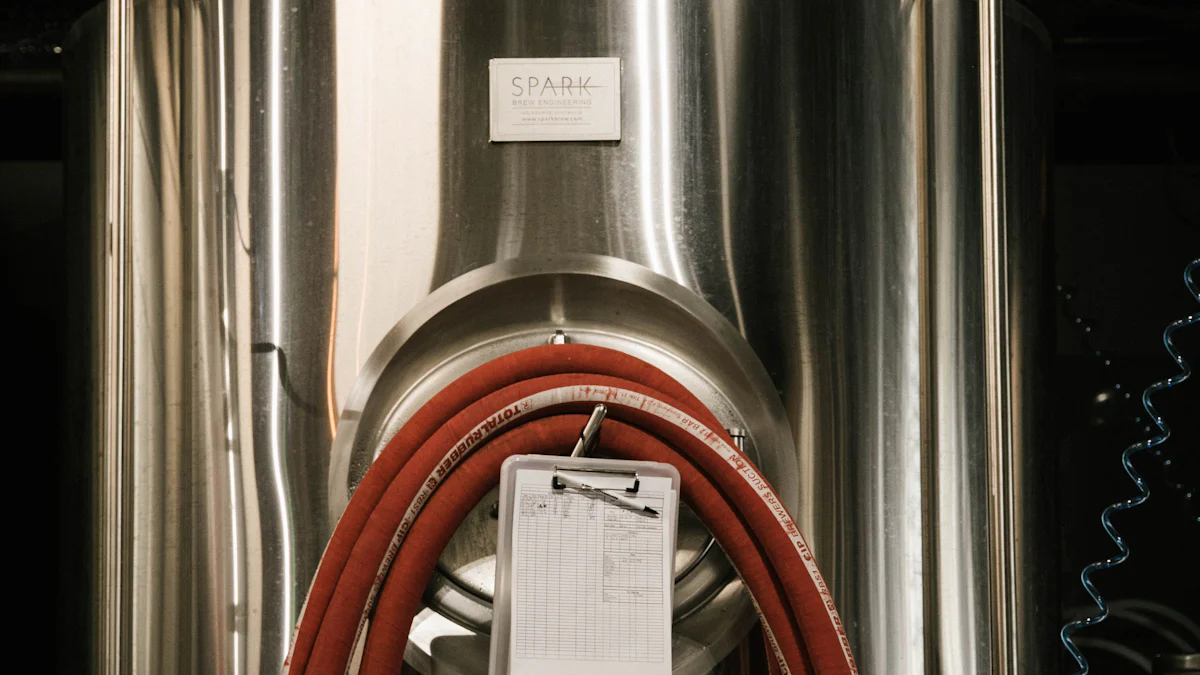
Adaptability to Technological Innovations
Stainless steel tanks have transformed modern winemaking by seamlessly integrating with advanced technologies. These tanks enhance your ability to control every aspect of the fermentation process. Their superior heat transfer properties allow you to regulate temperature with precision, ensuring optimal conditions for yeast activity. This control helps you develop specific aromas and flavors in your wine.
The design of stainless steel tanks also supports homogeneous mixing. Built-in mixing systems evenly distribute yeast and nutrients, improving fermentation efficiency. This uniformity enhances the extraction of color and flavor compounds, resulting in a richer and more vibrant wine. Additionally, the tanks’ airtight construction minimizes oxygen exposure, preserving the wine’s freshness and vibrancy.
Durability is another key advantage. Stainless steel tanks last significantly longer than oak barrels, maintaining consistent quality across vintages. Their smooth, non-porous surface simplifies cleaning and reduces the risk of contamination. This ease of maintenance not only saves time but also promotes sustainability in your winemaking process. By adopting stainless steel tanks, you can embrace technological innovations while producing high-quality wine.
Meeting Consumer Demand for Pure and Sustainable Wines
Today’s consumers increasingly seek wines that reflect authenticity and sustainability. Stainless steel tanks align perfectly with these preferences. Their non-reactive surface ensures a clean, pure taste, allowing the natural flavors of the grapes to shine. This feature is especially important for craft wineries aiming to produce artisanal beverages with distinct character.
Precise temperature control during fermentation and aging further enhances the wine’s quality. You can maintain a stable environment that preserves the wine’s authentic taste, meeting the demand for pure and unaltered flavors. Stainless steel tanks also offer long-term durability, reducing the need for frequent replacements. This longevity minimizes waste and supports environmentally conscious winemaking practices.
By choosing stainless steel tanks, you cater to the growing trend for sustainable and high-quality wines. These tanks empower you to meet consumer expectations while maintaining efficiency and consistency in your production process.
Chenma Stainless Steel Tanks: A Trusted Solution for Winemakers
Advanced Manufacturing Standards
Chenma’s stainless steel tanks are crafted with precision and adhere to the highest manufacturing standards. Each tank undergoes rigorous pressure testing and continuous inspections to ensure it meets international benchmarks. This commitment to quality guarantees that you receive a product designed for durability and performance.
Chenma’s adherence to advanced standards is reflected in its certifications:
| Certification/Standard | Description |
|---|---|
| ISO9001-2005 | Quality management system certification |
| ISO14001-2015 | Environmental management system certification |
| OHSAS18001-2007 | Occupational health management system certification |
| EU CE certification | Compliance with European safety standards |
These certifications demonstrate Chenma’s dedication to excellence. By choosing Chenma, you gain access to tanks that meet stringent global requirements, ensuring reliability in your winemaking process.
Customization for Unique Winemaking Needs
Chenma understands that every winemaker has unique requirements. Their stainless steel tanks can be tailored to suit your specific needs, whether you operate a boutique winery or a large-scale production facility.
You can customize various features, including:
- Tank Size and Shape: Options range from compact designs for small batches to larger tanks for high-volume production.
- Cooling Systems: Integrated cooling jackets help regulate fermentation temperatures with precision.
- Mixing Mechanisms: Built-in agitators ensure even distribution of yeast and nutrients.
- Additional Accessories: Sampling ports, sight glasses, and valves enhance usability and monitoring.
Chenma’s talented engineers work closely with you to design tanks that align with your winemaking goals. This flexibility allows you to optimize production while maintaining the highest quality standards.
Certifications and Quality Assurance
Chenma ensures that every tank meets rigorous quality and safety standards. Their stainless steel tanks come with certifications that guarantee compliance with industry regulations. These include:
| Certification/Standard | Description |
|---|---|
| ISO9001-2005 | Quality management system certification |
| ISO14001-2015 | Environmental management system certification |
| OHSAS18001-2007 | Occupational health management system certification |
| EU CE certification | Compliance with European safety standards |
These certifications reflect Chenma’s commitment to producing tanks that are safe, reliable, and environmentally responsible. By adhering to these standards, Chenma ensures that you receive a product that supports both your winemaking and sustainability goals.
With Chenma, you can trust that your tanks are built to the highest standards, offering unmatched quality and performance for your winery.
Why Stainless Steel Fermentation Tanks Are the Future of Wine Aging
Combining Practicality and Precision
Stainless steel fermentation tanks wine offer a unique combination of practicality and precision, making them the future of wine aging. These tanks provide an airtight environment that minimizes oxygen exposure, preserving the vibrant fruit flavors of your wine. Their neutral surface ensures no external flavors or aromas interfere with the natural expression of the grape varietals. This allows you to craft wines that reflect their true character.
The smooth, non-porous surface of stainless steel makes cleaning and maintenance efficient. You can easily sanitize the tanks, reducing the risk of bacterial contamination. This feature ensures consistent quality across batches, saving you time and effort. Additionally, stainless steel tanks are cost-effective. Their long lifespan and low maintenance requirements reduce expenses over time, making them a smart investment for wineries.
| Benefit | Description |
|---|---|
| Preservation of freshness | Provides an airtight environment, minimizing oxygen exposure and preserving vibrant fruit flavors. |
| Neutral influence | Does not impart flavors or aromas, allowing true expression of grape varietals. |
| Easy maintenance and sanitation | Smooth surfaces minimize bacterial growth and make cleaning efficient. |
| Cost-effectiveness | Longer lifespan and lower maintenance costs compared to oak barrels. |
| Versatility | Allows experimentation with different techniques and fermentation processes. |
This combination of features ensures that stainless steel tanks meet the demands of modern winemaking while maintaining the highest standards of quality.
Supporting Sustainable and Efficient Winemaking
Stainless steel tanks contribute significantly to sustainable and efficient winemaking practices. Their durability reduces the need for frequent replacements, aligning with environmentally conscious production methods. The recyclable nature of stainless steel further minimizes waste and conserves resources.
Modern stainless steel tanks often include insulation to reduce heat loss or gain. This feature lowers energy consumption during fermentation, helping you maintain optimal temperatures with less effort. The airtight design also slows oxidation, preserving wine quality while reducing the energy required for temperature adjustments.
- Key sustainability benefits of stainless steel tanks:
- Long lifespan reduces the demand for raw materials.
- Recyclability supports a circular economy.
- Non-porous surfaces prevent contamination, ensuring batch integrity.
- Easy maintenance cuts down on water and chemical use.
Precise temperature control is another advantage. Stainless steel’s excellent thermal conductivity allows you to regulate fermentation conditions with accuracy. This ensures high-quality wine production while minimizing energy costs. By choosing stainless steel tanks, you not only enhance efficiency but also support environmentally friendly winemaking practices.
Stainless steel aging represents the perfect balance between innovation and sustainability. These tanks empower you to produce exceptional wines while reducing your environmental impact.
Stainless steel fermentation tanks stand out as the ultimate solution for wine ageing. Their durability and corrosion resistance ensure long-term reliability, while their non-porous surface preserves the wine’s natural flavors. You can easily clean and sanitize these tanks, maintaining hygiene and preventing contamination. Precise temperature control allows you to create optimal conditions for fermentation and ageing, ensuring consistent quality across batches.
Modern winemakers prefer stainless steel tanks for their ability to minimize oxidation and maintain freshness. Whether you’re crafting a bold red or a crisp white, these tanks empower you to produce wines that reflect their true character. By choosing stainless steel, you embrace a future of efficient, sustainable, and high-quality winemaking.
FAQ
What makes stainless steel tanks better than oak barrels for wine aging?
Stainless steel tanks preserve the wine’s natural flavors without adding external notes. They last longer, require less maintenance, and offer precise temperature control. Oak barrels, in contrast, impart woody flavors and need frequent replacement. Stainless steel provides a cleaner, more consistent aging process.
Can stainless steel tanks be used for both red and white wines?
Yes, stainless steel tanks work perfectly for both red and white wines. Their neutral surface ensures no flavor interference, allowing the natural characteristics of each wine to shine. You can also adjust the temperature to suit the specific needs of red or white wine fermentation.
How do stainless steel tanks contribute to sustainability?
Stainless steel tanks are 100% recyclable, reducing waste and conserving resources. Their long lifespan minimizes the need for replacements. Insulated designs lower energy consumption during fermentation, making them an environmentally friendly choice for winemaking.
Are stainless steel tanks customizable for different winemaking needs?
Absolutely! You can customize tank size, shape, cooling systems, and accessories like sampling ports or mixing mechanisms. This flexibility allows you to tailor the tanks to your production scale and winemaking style, ensuring optimal results.
Do stainless steel tanks require special cleaning methods?
No, cleaning stainless steel tanks is straightforward. Use a high-pressure rinse, an alkaline cleaner, and hot water or approved sanitizers. Their smooth, non-porous surface resists bacterial growth, making maintenance quick and effective.

